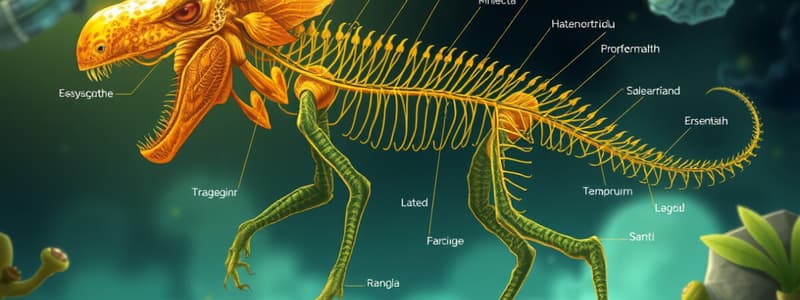Podcast
Questions and Answers
What does the first part of a scientific name represent?
What does the first part of a scientific name represent?
- Species
- Family
- Phylum
- Genus (correct)
Which of the following classifications is the largest group in biological taxonomy?
Which of the following classifications is the largest group in biological taxonomy?
- Phylum
- Class
- Species
- Kingdom (correct)
What is the main function of respiration in living organisms?
What is the main function of respiration in living organisms?
- To produce energy (correct)
- To remove toxins
- To facilitate growth
- To take in nutrients
Which process primarily involves the removal of waste products in organisms?
Which process primarily involves the removal of waste products in organisms?
What is the correct definition of a species?
What is the correct definition of a species?
In biological classification, what is the term for a group below the order level?
In biological classification, what is the term for a group below the order level?
What term describes the permanent increase in size and dry mass of an organism?
What term describes the permanent increase in size and dry mass of an organism?
Which of the following best describes movement in living organisms?
Which of the following best describes movement in living organisms?
What best defines sensitivity in organisms?
What best defines sensitivity in organisms?
Which of the following is NOT a characteristic of living things?
Which of the following is NOT a characteristic of living things?
What is the function of nutrition in living organisms?
What is the function of nutrition in living organisms?
Which statement accurately describes the process of respiration?
Which statement accurately describes the process of respiration?
How are the classifications of 'class' and 'order' related in biological taxonomy?
How are the classifications of 'class' and 'order' related in biological taxonomy?
What does excretion primarily involve in living organisms?
What does excretion primarily involve in living organisms?
Which of the following best represents the concept of genus in biological classification?
Which of the following best represents the concept of genus in biological classification?
Flashcards are hidden until you start studying
Study Notes
Nomenclature
- Scientific names consist of two words; the first is the genus (capitalized) and the second is the species (lowercase).
- Both parts are written in Latin, either in italics or underlined.
- Example: Humans are named Homo sapiens, where Homo is the genus and sapiens is the species.
Taxonomic Hierarchy
- Kingdom: The largest grouping of living organisms sharing common features, subdivided into phyla (e.g., Plant Kingdom, Animal Kingdom).
- Phylum: Groups organisms with similar characteristics, further divided into classes (e.g., Phylum Arthropoda).
- Class: Categories within a phylum that share traits and are divided into orders (e.g., Class Insects, Class Arachnids).
- Order: A subdivision of classes, organized into families.
- Family: Groups of related organisms classified into genera.
- Genus: Comprises species with shared traits, which can be further divided into individual species.
- Species: A group of organisms with common characteristics capable of breeding to produce fertile offspring (e.g., humans, cats, dogs).
Biological Processes
- Respiration: Chemical reactions in living cells that break down nutrients to release energy for metabolic activities.
- Nutrition: The intake of organic substances and minerals for growth, tissue repair, development, and energy production.
- Excretion: The removal of toxic substances, metabolic waste, and excess materials from the body.
- Metabolism: Refers to the total of chemical reactions within cells, including respiration.
- Growth: A permanent increase in an organism's size and mass, measured by the increase in cell number or size after removing water content.
- Reproduction: The biological processes that result in the production of more organisms of the same kind.
- Movement (Locomotion): Any action by an organism causing a change in position or place.
- Sensitivity: The capability to sense and respond to changes in the internal or external environment; stimuli are the triggers for response.
Nomenclature
- Scientific names consist of two words; the first is the genus (capitalized) and the second is the species (lowercase).
- Both parts are written in Latin, either in italics or underlined.
- Example: Humans are named Homo sapiens, where Homo is the genus and sapiens is the species.
Taxonomic Hierarchy
- Kingdom: The largest grouping of living organisms sharing common features, subdivided into phyla (e.g., Plant Kingdom, Animal Kingdom).
- Phylum: Groups organisms with similar characteristics, further divided into classes (e.g., Phylum Arthropoda).
- Class: Categories within a phylum that share traits and are divided into orders (e.g., Class Insects, Class Arachnids).
- Order: A subdivision of classes, organized into families.
- Family: Groups of related organisms classified into genera.
- Genus: Comprises species with shared traits, which can be further divided into individual species.
- Species: A group of organisms with common characteristics capable of breeding to produce fertile offspring (e.g., humans, cats, dogs).
Biological Processes
- Respiration: Chemical reactions in living cells that break down nutrients to release energy for metabolic activities.
- Nutrition: The intake of organic substances and minerals for growth, tissue repair, development, and energy production.
- Excretion: The removal of toxic substances, metabolic waste, and excess materials from the body.
- Metabolism: Refers to the total of chemical reactions within cells, including respiration.
- Growth: A permanent increase in an organism's size and mass, measured by the increase in cell number or size after removing water content.
- Reproduction: The biological processes that result in the production of more organisms of the same kind.
- Movement (Locomotion): Any action by an organism causing a change in position or place.
- Sensitivity: The capability to sense and respond to changes in the internal or external environment; stimuli are the triggers for response.
Studying That Suits You
Use AI to generate personalized quizzes and flashcards to suit your learning preferences.




